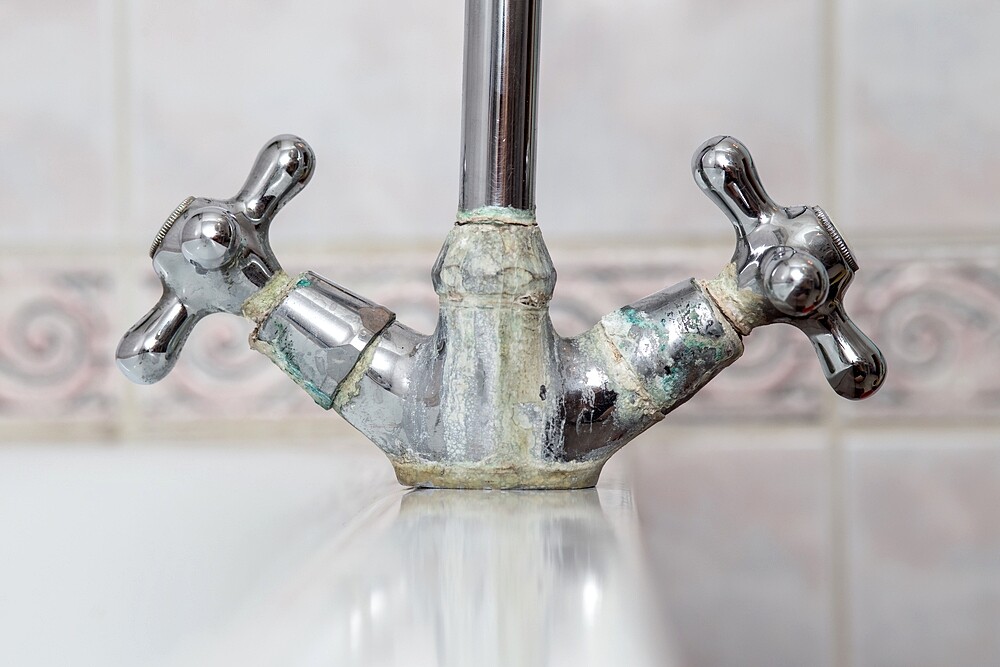Limescale stains are among those spots that particularly bother us! No sooner has the bathroom been cleaned than they start spreading again… Find out here how you can remove and prevent limescale!
How do limescale stains develop?
Water containing limescale is enriched with a particularly high amount of calcium carbonate. The caclium carbonate enters the groundwater if calcareous rock is present in the region. The higher the concentration, the harder the water and the more lime is deposited. Limescale deposits occur mainly when water is heated or when it evaporates. The white patches are not only a thorn in the side, but also an eldorado for bacteria, which can settle better on the rough surface. To find out whether you have particularly calcareous water, you can have the water hardness measured.
Where is limescale deposited?
Limescale stains are found where water is used: so mainly in the bathroom and kitchen. Accordingly, limescale deposits on fittings, tiles, in washbasins, in the shower or on taps and shower heads. And, of course, lime deposits also occur in appliances and machines that deal with water and high temperatures. This applies, for example, to kettles, dishwashers, washing machines and coffee makers.
Lime Removal – The best home remedies
To remove limescale, an acidic cleaning agent is required that has a pH value between one and four. Which cleaning agent is the best choice also depends on the surface, however. In case of doubt, the agent should always be tested on a small area before it is applied to a large surface.
1. Removing limescale with vinegar or vinegar essence
Vinegar is a well-tried household remedy to successfully remove limescale stains. Depending on the severity of the deposits, either a few drops of vinegar are diluted with water or, in the case of severe lime stains, vinegar essence is applied undiluted.
Use a cotton cloth to apply either pure or diluted vinegar essence to the limescale soiled surfaces. Leave everything to soak in well (preferably overnight) and then rinse with clean, cold water. By rubbing the surfaces dry afterwards, you prevent the formation of new stains.
Tip: You can also apply vinegar to the glass walls of a shower with a damp microfibre cloth.
Worth knowing about vinegar
- Vinegar must not be used on aluminium.
- Acetic acid is corrosive and can therefore also be harmful to paints, marble or plastics. Therefore, avoid using the cleaning agent on these materials.
- When cleaning tiles you should leave out the joints, as the cement could be attacked. Alternatively, you can water the joints well before cleaning – this prevents the vinegar from being absorbed.
- Protect your hands with household gloves, as vinegar can irritate the skin.
- To spread the product over a large area, it can be diluted and filled into a spray bottle.
2. Removing limescale with citric acid
Light limescale deposits can be efficiently cleaned with citric acid: The powder is mixed with lukewarm water and then applied. Wipe everything with a cloth afterwards. Citric acid is milder than vinegar and available in drugstores.
Do not use the citric acid on aluminium!
3. Removing limescale with toothpaste
Toothpaste is also an effective means of removing limescale – especially for corners, chrome fittings or in joints. To do this, let the toothpaste work for a while. If necessary, you can remove stubborn dirt with an old toothbrush before rinsing the surfaces thoroughly with cold water and then drying them.
4. Removing limescale with cola
Especially in the toilet, cola is the solution to remove urine scale and lime scale. Pour a whole bottle into the toilet and let it work for one night. The next morning clean with a toilet brush and flush at the end.
4. Removing limescale with baking powder
The mixture of water and baking powder to a mushy mass is suitable for the removal of lime stains on aluminium. This household remedy also requires a short reaction time before it is rinsed off with plenty of water.
Avoid limescale stains: Here’s how to do it
- Warm water in particular forms lime spots – so it helps if you rinse wet surfaces with cold water.
- Drying wet surfaces is the best way to prevent lime stains. This way the limescale in the water cannot settle at all. If you want to avoid lime stains in your shower, it is recommended that you remove all water drops with a squeegee directly after showering!

